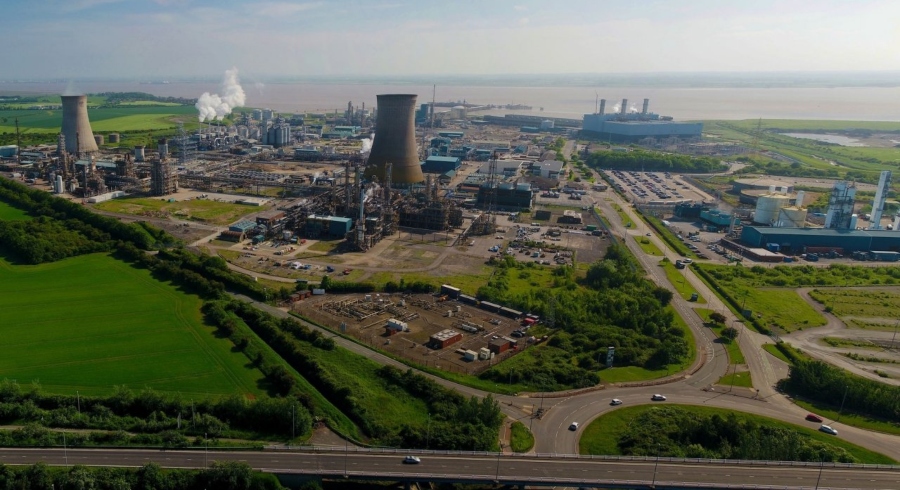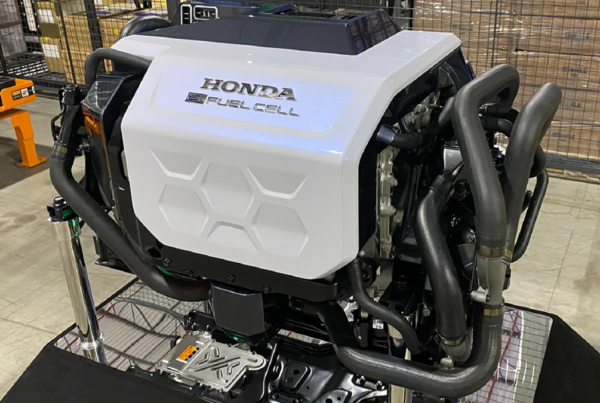
- The plan is backed by six prospective industrial operators who have signed varying agreements for the development and commercialisation of the project.
Equinor has formally submitted plans for its ‘Hydrogen to Humber (H2H) Saltend’ hydrogen production facility into phase two of the Government’s Cluster Sequencing Process, supported by a series of co-operation agreements with prospective regional hydrogen users, which could be a world first and a catalyst for the Humber to achieve net zero.
H2H Saltend is Equinor’s flagship 600 megawatts low carbon hydrogen production plant with carbon capture, located in Saltend, to the east of Hull. The Humber region is the most carbon intensive industrial cluster in the UK and H2H Saltend could enable industries at Saltend Chemicals Park and the East Yorkshire area to reduce CO2 emissions by nearly one million tonnes annually, representing a 30% reduction in the Saltend Chemicals Park’s total current emissions.
The plan is backed by six prospective industrial operators who have signed varying agreements for the development and commercialisation of the project, including potential future hydrogen supply. Fuel switching from natural gas to low carbon hydrogen would support decarbonisation of the Humber region and further accelerate the development of what could be a world first-of-a-kind hydrogen value chain project.
- Centrica Storage operates the Easington gas storage site in East Yorkshire and offshore platforms in the North Sea. Fuel switching from gas to hydrogen can help to reduce its emissions at Easington.
- INEOS Acetyls supplies chemicals for a wide range of downstream industries such as food, pharmaceuticals, paints, adhesives and packaging from its site at Saltend Chemicals Park. Using hydrogen instead of fossil fuels within its processes can reduce its emissions and produce lower carbon chemicals for wider use in the economy or for export.
- Pensana is in the process of establishing the UK’s first independent and sustainable rare earths processing facility at Saltend Chemicals Park. This will support a range of industries vital to meeting the country’s Net Zero ambitions, including Electric Vehicles and offshore wind. Utilising Hydrogen in the processing of end-of-life permanent magnets allows low energy recovery of the critical rare earths to be reused in this important supply chain.
- Triton Power operates Saltend Power Station, currently natural gas-fired and providing power and steam primarily to the Chemicals Park. By switching from fossil fuels to low carbon hydrogen it can accelerate the decarbonisation of the Park and its other users.
- Vital Energi is the energy services provider to the Yorkshire Energy Park, a proposed energy and technology park located within the Humber Freeport Zone. Using hydrogen within its electricity generation, heating and cooling can contribute to a low carbon park facility, helping to attract environmentally conscious companies.
- Vivergo Fuels is a renewable bioethanol fuel producer based at Saltend Chemicals Park. Its bioethanol will be blended with petrol to create E10 fuel, when the plant reopens in early 2022. They will be collaborating with Equinor on assessing the potential for hydrogen to be used as a low carbon fuel alternative to natural gas within the drying of its co-produced animal feed.

Equinor’s CEO Anders Opedal and Irene Rummelhoff, executive vice president MMP, visiting Saltend Chemicals Park.
Beyond these initial off-takers, the low carbon hydrogen could also be used much wider, helping to decarbonise multiple sectors such as heavy industry, transport, heating and pharmaceuticals across the Humber region.
The submission has also been accompanied by 23 letters of support from organisations across the region including MPs, local authorities, LEPs, business and trade bodies, educational institutions and diversity groups.
It also coincides with the signing of an agreement with px Group, owner and operator of Saltend Chemicals Park, confirming the project location.
H2H Saltend is the kick-starter project for the wider Zero Carbon Humber scheme, a UKRI-supported partnership of twelve organisations committed to making the Humber the world’s first net zero industrial cluster by 2040.
It is also the essential building block for Equinor’s ‘Hydrogen to Humber’ ambitions which seeks to establish at least 1.8 Gigawatts of production in the region by 2030, over one third of the Government’s UK-wide target. In partnership with SSE Thermal, Equinor is planning to develop the world’s first at-scale 100% hydrogen power station at Keadby in Lincolnshire and a proposed hydrogen storage facility at Aldbrough in East Yorkshire. In partnership with gas distribution network operator Cadent, Equinor recently announced plans for potential hydrogen town trials in northern Lincolnshire, in line with the Government’s ambition to decarbonise domestic heating.
In October the Department for Business, Energy and Industrial Strategy (BEIS) announced that the East Coast Cluster, of which Zero Carbon Humber is the largest regional industrial cluster, was one of two successful national bids in Phase One of its Cluster Sequencing Process. This allows individual decarbonisation projects within the cluster to enter Phase Two. Submissions closed on 21st January and a result is expected around May 2022.
Equinor has also submitted three other projects into the process. These include two new carbon capture power stations at Keadby and Peterhead, both developed together with SSE Thermal, as well as the Net Zero Teesside Power project which is developed in partnership with bp.
Irene Rummelhoff, executive vice president for Marketing, Midstream and Processing at Equinor, said:
“We are delighted to submit our formal plans to Government for our flagship H2H Saltend project, as well as three other low carbon projects across the UK. This shows the strength of ambition from Equinor in the UK, building on its considerable experience of similar projects internationally.
“H2H Saltend is an exciting ground-breaking project which will provide low carbon hydrogen to multiple industries in the Humber by 2026, and the demand for this is clear from the industrial operators’ agreements we already have in place. Importantly, it is also a major step to a wider hydrogen economy which can reduce emissions across several sectors, act as a catalyst for greater inward investment and economic growth, and working with our partners, also ultimately result in a Zero Carbon Humber.”
ABOUT EQUINOR
Equinor is the country’s leading energy provider, supplying natural gas, oil and electricity, and aims to reach net zero emissions globally by 2050. It is a leader in carbon capture & storage and hydrogen, developing the H2H Saltend low-carbon hydrogen production plant that is at the heart of the Zero Carbon Humber partnership.
It is collaborating with SSE Thermal on low-carbon power projects using hydrogen and carbon capture in the Humber and a further carbon capture power project in Scotland. It is partnering in the Net Zero Teesside power project and, as part of the Northern Endurance Partnership, it is developing CO2 transport and storage infrastructure for the East Coast Cluster, comprising the Humber and Teesside. Equinor’s UK activities also include operating offshore oil and gas fields and offshore wind farms, and its expansion plans include Dogger Bank, the world’s largest offshore wind farm.
Find out more at www.equinor.co.uk.
ABOUT CENTRICA STORAGE
Centrica Storage Ltd is headquartered in Hessle with operational sites at Easington gas terminal and offshore platforms in the Southern North Sea. It has two decades of experience in engineering, projects and operations having delivered major capital projects for third parties including the Langeled gas receiving facility, the York gas field and recently the Tolmount gas field extending the life of its terminal by a further 15 years.
CSL are part of the Centrica Group, the owners of British gas and are passionate about the decarbonisation of the energy mix to ensure it helps its customers manage their carbon footprint whilst creating a better environment for all.
ABOUT INEOS ACETYLS
INEOS Acetyls produces acetic acid, acetic anhydride and ethyl acetate, important raw materials used in a wide range of end products, such as adhesives, construction, food packaging, inks, fragrances, laundry powders, textiles, paints, pharmaceuticals and solar energy.
The site in Hull has been operating for over 100 years and is the biggest producer of acetyls products in Europe, employing more than 300 people. It has a long tradition of world leading, lower carbon production.
INEOS Acetyls is a global business, with production capability in the US, Asia and Trinidad & Tobago in addition to the Hull site. It became part of INEOS, one of the world’s largest chemicals companies, as part of its $5 billion acquisition of the bp petrochemicals business in January 2021.
Visit YouTube to watch this business profile of INEOS Acetyls.
ABOUT PENSANA
LSE listed Pensana plc mines, processes, and supplies the critical components needed for the manufacturing of environmentally strategic infrastructure, such as wind turbines and electric vehicles.
Pensana is in the process of establishing the UK’s first independent and sustainable rare earths processing facility at Saltend Chemicals Park. This will aim to produce c.12,500 tonnes a year of rare earth oxides at the plant, representing c.5 per cent of the world market in 2025. The plant will process rare earth sulphates imported primarily from Pensana’s Longonjo mine in Angola.
As part of Pensana’s commitment to the circular economy it is looking to recycle an addressable annual market of 4,000 tonnes of end-of-life permanent magnets using an innovative hydrogen decrepitation process. Pensana is looking to secure a long-term supply of hydrogen from Equinor’s Hydrogen to Humber anchor project at Saltend.
ABOUT TRITON POWER
Triton Power is a leading independent power generating company. It provides power to the UK wholesale electricity market through its UK power stations, including Saltend Power Station which is ideally situated to support the decarbonisation of the Humber region.
Saltend Power Station is a natural gas-fired power station providing power and steam to the Saltend Chemicals Park, by switching from fossil fuels to low carbon hydrogen the power plant is in a unique position to kick start the decarbonisation of the Saltend Chemicals Park site. This will lead the way for the Park to achieve net zero by 2035 – a UK first.
Triton Power is leading the way supporting the electricity system operator achieve a zero-carbon electricity system by providing stability services to keep the system stable in a world first approach – which uses less energy and reduces carbon emissions.
ABOUT VITAL ENERGI
Vital Energi provides efficient energy generation, distribution and management services to support customers in multiple sectors in their transition to net zero carbon emissions. Vital Energi will be the energy services provider on the Yorkshire Energy Park, a next generation energy and technology park located in the Humber Freeport Zone. Vital Energi is keen for the energy infrastructure at Yorkshire Energy Park to integrate closely with local energy generators and users, and the use of hydrogen as a fuel to generate electricity, heat and cooling offers an excellent route to decarbonisation.
ABOUT VIVERGO FUELS
Vivergo Fuels is a renewable biothanol an animal feed producer based at Saltend Chemicals Park it takes feed-grade wheat grown at local farms in Yorkshire and Lincolnshire and processes it – with virtually no waste – into bioethanol (a green transport fuel that is mixed with regular petrol at the pump) and protein rich animal feed for cows (and other animals too).
The majority of the feed wheat which will be used by Vivergo Fuels will have been grown in the local area for generations, and much was historically exported. This same land and wheat will now be used again to produce two high value commodities.
Vivergo Fuels was initially formed in 2007 as a joint venture between AB Sugar, BP and Du Pont, to create a Biofuels Business for the future. In 2015 and 2017 AB Sugar respectively acquired BP and Du Pont’s share to become the sole shareholder of Vivergo Fuels.
Read the most up to date Fuel Cell and Hydrogen Industry news at FuelCellsWorks




